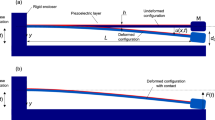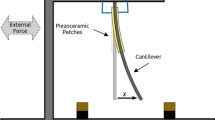Abstract
We consider memelements (memristors and memductors) with special periodic responses (mixed-mode oscillations) and 2D one-period loops yielding constant parameters describing the memelements as single units or components of oscillating circuits. One of the parameters is the action parameter having the dimensions of energy \(\times \) time and the SI unit Joule \(\times \) second. The remaining loops and parameters correspond to energy of magnetic and electric fields, power and rms current and voltage values. Special mixed one-period loops are also analyzed with pairs of signals associated with two different components of the circuits. The areas enclosed by various loops result in special equations which can be derived from the underlying ODE model of the circuits. The action of a memelement is equivalent to the time integral of the Lagrangian \(L(w,w')\), where w is the internal state variable of a memelement. The analysis of memristive circuits and their parameters is considered in the framework of mixed-mode oscillations. Also, the unit of action for memelements is proposed to be called Chua (\(=\) Joule \(\,\times \) second) to honor L.O. Chua for his work on memristors and memristive circuits.






Similar content being viewed by others
Notes
“In physics, action is an attribute of the dynamics of a physical system. It is a mathematical functional which takes the trajectory, also called path or history, of the system as its argument and has a real number as its result. Generally, the action takes different values for different paths. Action has the dimensions of (energy) \(\times \) (time), and its SI unit is joule-second. This is the same unit as that of angular momentum” [23].
References
Chua, L.O.: Memristor—the missing circuit element. IEEE Trans. Circuit Theory 18, 507–519 (1971)
Chua, L.O.: The fourth element. Proc. IEEE 100, 1920–1927 (2012)
Deyan, Lin, Ron, S.Y., Hui, Chua L.O.: Gas discharge lamps are volatile memristors. IEEE Trans. Circuits Syst. I: Regul. Pap. 61, 2066–2073 (2014)
Strukov, D.B., Snider, G.S., Stewart, D.R., Williams, R.S.: The missing memristor found. Nature 453, 80–83 (2008)
Pershin, Y.V., Di Ventra, M.: Memory effects in complex materials and nanoscale systems. Adv. Phys. 60, 145–227 (2011)
Georgiu, P.S., Yaliraki, S.N., Drakakis, E.M., Barahona, M.: Quantitative measure of hysteresis for memristors through explicit dynamics. arXiv:1011.0060v3 (cond-mat.mes-hall), 17 July 2011
Marszalek, W., Trzaska, Z.W.: Memristive circuits with steady-state mixed-mode oscillations. Electron. Lett. 50, 1275–1277 (2014)
Riaza, R.: Second order mem-circuits. Int. J. Circuit Theory Appl. (2014). doi:10.1002/cta.2037
Biolek, D., Di Ventra, M., Pershin, Y.V.: Reliable SPICE simulations of memristors, memcapacitors and memductors. arXiv: 1307.2717v1 (physics.comp-ph), 10 July 2013
Biolek, D., Biolek, Z., Biolkova, V.: Pinched hysteretic loops of ideal memristors, memcapacitors and meminductors must be ‘self-crossing’. Electron. Lett. 47, 1385–1387 (2011)
Biolek, D., Biolek, Z., Biolkova, V.: Interpreting area of pinched memristor hysteresis loop. Electron. Lett. 50, 74–75 (2014)
Petrov, V.: Mixed-mode oscillations in chemical systems. J. Chem. Phys. 97, 6191–6198 (1992)
Milton, J., Jung, P. (eds.): Epilepsy as a Dynamic Disease. Springer, Berlin (2003)
McGuinness, M., Hong, Y., Galletly, D., Larsen, P.: Arnold tongues in human cardiorespiratory systems. Chaos 14, 1–6 (2004)
Brøns, M., Kaper, T.J., Rotstein, G. (eds.): Focus issue: mixed-mode oscillations: experiment, computation, and analysis. Chaos 18, 015101 (2008)
Mikikian, M., Cavarroc, M., Coude, L.I., Tessier, Y., Boufendi, L.: Mixed-mode oscillations in complex-plasma instabilities. Phys. Rev. Lett. 100, 225005 (2008)
Marszalek, W., Trzaska, Z.W.: Mixed-mode oscillations and chaotic solutions of jerk (Newtonian) equations. J. Comput. Appl. Math. 262, 373–383 (2014)
Marszalek, W., Trzaska, Z.W.: Mixed-mode oscillations in a modified Chua’s circuit. Circuits Syst. Signal Process. 29, 1075–1087 (2010)
Marszalek, W.: Circuits with oscillatory hierarchical Farey sequences and fractal properties. Circuits Syst. Signal Process. 31, 1279–1296 (2012)
Hausner, M.J.B., Gallas, J.A.C.: Nonchaos-mediated mixed-mode oscillations in an enzyme reaction system. J. Phys. Chem. Lett. 5, 4187–4193 (2014)
Podhaisky, H., Marszalek, W.: Bifurcations and synchronization of singularly perturbed oscillators: an application case study. Nonlinear Dyn. 69, 949–959 (2012)
Sandler, S.M., Hymowitz, C.: SPICE Circuit Handbook. McGraw- Hill, New York (2006)
Action (Physics). http://en.wikipedia.org/wiki/Action_(physics)
Planck Constant. http://en.wikipedia.org/wiki/Planck_constant
Acknowledgments
The author would like to thank the three anonymous reviewers for their helpful comments.
Author information
Authors and Affiliations
Corresponding author
Appendix
Appendix
Equation (3) describes the memristive circuits with MMOs shown in Fig. 7. For bifurcation diagrams, more time-domain responses and pinched hysteresis loops see [7].
Two dual memristive circuits described by (3) with \(x=\eta \overline{x}\). a The M+CLRC circuit with memductance g(w) for \(w=\phi \), b The M+LGCL circuit with memristance g(w) for \(w=q\)
Finally, suppose that we use [x(0), y(0), z(0), w(0)] as the nonzero initial conditions of (3). It is possible to transform system (3) into a singularly perturbed scalar ODE in variable w(t) and use it in a SPICE [22] realization of the circuits in Fig. 7a, b. The scalar equation is (the modified version of the second equation in (3) with \(a_s\) is used as discussed in Sect. 2):
In the process of deriving (10) we also obtain the following initial conditions in addition to w(0)
A similar approach was successfully used in [17, 21] for a third-order jerk equation yielding MMOs in a circuit with a nonlinear element of third-degree polynomial current–voltage characteristic. Moreover, it was shown that some of the singularly perturbed jerk equations were Newtonian, since they were obtained after differentiation of the Newton’s second law of the type \(w''=F(t,w,w')/m\) with m being constant. In such a situation, the \(w''\) has the meaning of acceleration, \(F(t,w,w')\) is a nonlinear force (with a memory term) and \(w'''\), being derivative of \(w''\) has the meaning of jerk. If the same analysis can be extended to (10), then \(w''''\) will have the meaning of jounce, the second derivative of acceleration \(w''\). Such an approach will link the memristive MMOs circuits with their equivalent mechanical realizations.
Rights and permissions
About this article
Cite this article
Marszalek, W. On the action parameter and one-period loops of oscillatory memristive circuits. Nonlinear Dyn 82, 619–628 (2015). https://doi.org/10.1007/s11071-015-2182-2
Received:
Accepted:
Published:
Issue Date:
DOI: https://doi.org/10.1007/s11071-015-2182-2





